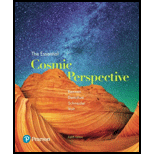
Concept explainers
How Does the Table Know? Thinking deeply about seemingly simple observations sometimes reveals underlying truths that we might otherwise miss. For example, think about holding a golf ball in one hand and a bowling ball in the other. To keep them motionless, you must actively adjust the tension in your arm muscles so that each arm exerts a different upward force that exactly balances the weight of each ball. New, think about what happens when you set the balls on a table. Somehow, the table exerts exactly the right amount of upward force to keep the balls motionless, even though their weights are very different. How does a table know” to make the same type of adjustment that you make consciously when you hold the balls motionless in your hands? (Hint: Think about the origin of the force pushing upward on the objects.)
Want to see the full answer?
Check out a sample textbook solution
Chapter 4 Solutions
The Essential Cosmic Perspective (8th Edition)
- After completing this Lecture Tutorial, students should be able to: distinguish between scientific hypotheses and nonscientific ideas. Part 1: Comprehension of Hypotheses A scientific hypothesis needs to (1) be supported by the majority of current data and (2) be testable. An alien on Earth is wondering why a rubber ball falls back down to the ground after it is thrown into the air. It comes up with several ideas about the ball. a. Gravity is pulling the ball to the ground. b. A mystical force that cannot be measured is pushing the ball down. c. Earth's magnetic field is pulling on the rubber ball. 1. Which statement is NOT a hypothesis because it is not testable? a b c 2. Which statement is NOT a hypothesis because it is not supported by current data? a b c 3. Which statement IS a scientific hypothesis? a b c Part 2: Application to Dinosaur Extinction Below are possible scenarios explaining the extinction of the dinosaurs. a. Dinosaurs were killed off by a virus. b. A large meteorite…arrow_forwardHelparrow_forwardCAN YOU PLEASE SOLVE QUESTION 2 EXPLAINING STEP BY STEP ON A PICTURE. PLEASE JUST POST THE PICTURE OF YOUR WORK.arrow_forward
- Solve question no.6 and show a clear and organized solution. Thanks!!!Note: The answer is already given on the bottom side of the problem, just show the solution on how to get it.arrow_forwardA design for a wheel-type space station is depicted above. It consists of an outer wheel that is 80 m in diameter and has a width of 3 m, an inner hub of 6 m diameter, and four thin pylons connecting the hub to the ring as depicted above. The outer wheel has a mass of 210,000 kg, the inner hub has a mass of 60,000 kg, and each pylon has a mass of 10,000 kg. If we approximate the outer wheel as a torus, the hub as a solid disk, and each pylon as a thin rod, what would be a) the moment of inertia, b) the angular momentum, and c) the centripetal acceleration of the space station if it was spinning at a frequency of 3.3 RPM?arrow_forwardHello, please answer as soon as possible. Choose from the given choices/options below the question. Show complete solution. Thank you for your help. I’ll rate you with like/upvote.arrow_forward
- One design for a wheel-type space station is depicted above. It consists of an outer wheel that is 80 m in diameter and has a width of 3 m, an inner hub of 6 m diameter, and four thin pylons connecting the hub to the ring as depicted above. The outer wheel has a mass of 210,00 kg, the inner hub has a mass of 60,000 kg, and each pylon has a mass of 10,000 kg. If we approximate the outer wheel as a torus, the hub as a solid disk, and each pylon as a thin rod. a) The moment of inertia? b) the angular momantum? c) the centripetal acceleration of the space station if it was spinning at a frequency of 3.3 RPM?arrow_forwardThe class I'm taking is physics for scientists and engineers! I have attached the problem below! Please view attachment before answering. Thank you so so much!arrow_forwardSolve question no.4 and show a clear and organized solution. Thanks!!!Note: The answer is already given on the bottom side of the problem, just show the solution on how to get it.arrow_forward
- The class I'm taking is physics for scientists and engineers! I am completely stuck . please help. please post step-by-step solution to help me better understand . I have attached problem. Please view before answering. Thank you!arrow_forwards/ttyme/OneDrive%20-%20Select%20Education%20Group/ch03%20(1).pdf A In a popular amusement park ride, people stand on a circular platform which sits inside a vertical cylinder. As the cylinder and platform spin about a vertical axis, the riders feel as if they are pushed against the inside wall of the cylinder. Once the rotation rate becomes sufficiently high, the "floor" of the ride drops, leaving those inside effectively pinned to the wall. Draw force diagrams for the following cases. Is your force diagram consistent with the requirements for circular motion? Justify your answer. (a) The platform and the cylinder are spinning slowly. The people inside are standing on the floor.arrow_forward9, 10arrow_forward
 Physics for Scientists and Engineers: Foundations...PhysicsISBN:9781133939146Author:Katz, Debora M.Publisher:Cengage Learning
Physics for Scientists and Engineers: Foundations...PhysicsISBN:9781133939146Author:Katz, Debora M.Publisher:Cengage Learning AstronomyPhysicsISBN:9781938168284Author:Andrew Fraknoi; David Morrison; Sidney C. WolffPublisher:OpenStax
AstronomyPhysicsISBN:9781938168284Author:Andrew Fraknoi; David Morrison; Sidney C. WolffPublisher:OpenStax

